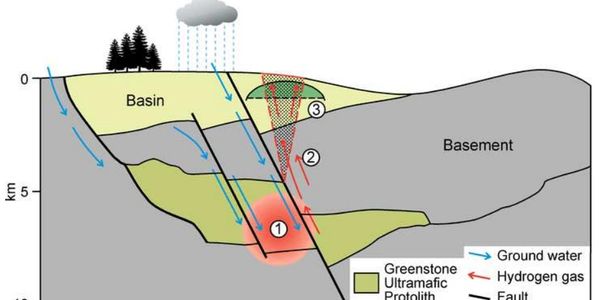Conferences and Publications
Publications in Press
The NHSG team has contributed to a recent publication in the AAPG-SEG Interpretation magazine, “A Natural Hydrogen carbonate play: Sandino Forearc Basin, Pacific Offshore Nicaragua” (Powney et al, 2025, https://doi.org/10.1190/INT-2024-0054.1).
The configuration and thermal structure of the margin are such that serpentinization of ultramafic protoliths and hydrogen generation is predicted to be occurring below the basin and outer high of the forearc. It is postulated that the hydrogen generated will move upward by buoyancy and access the sediments of the basin via faults and fracture networks formed by accretionary tectonics. Shallow-water carbonates have reservoir potential and are ideally placed to be charged by hydrogen emanating from the basement and form a natural hydrogen exploration play in the Sandino Basin. A copy of the paper, which has been made available as an OpenAccess paper, is available on request.

Greenstone Model
Ian Hutchinson and NHSG colleagues have prepared a paper entitled "Greenstones as a Source of Hydrogen in Cratonic Sedimentary Basins" that has been accepted for publication in an upcoming Geological Society of London Special Publication. In this paper a model is presented for the generation of natural hydrogen from cratonic basement rocks (greenstones) and its migration into the sediments of overlying cratonic basins.
The Special Publication volume was published in 2024 and an open access copy of the NHSG paper is available here.

H-NAT 23 Natural Hydrogen Summit, Freemantle
Andy Barnicoat represented NHSG at H-NAT23, and presented on the topic "Natural hydrogen sources compared from an exploration perspective".
The presentation introduced the hydrogen play model proposed by NHSG, consideration of the rates of hydrogen generation by different processes, the significance of redox buffers and highlighted implications for exploration. Serpentinisation is considered the most effective localised source for play-based exploration.
Natural Hydrogen: A New Frontier for Energy Geoscience, 2023
Members of the NHSG working with industry experts and the Geological Society of London convened a conference held at Burlington House in July 2023. The two day conference was well attended and addressed themes for how geoscience can be applied to the exploration for, and harnessing of, natural hydrogen, including play models, hydrogen habitats, similarities and differences with other natural resources, exploration techniques and ways to detect and measure natural hydrogen.
A second conference to be held at Burlington House is planned for July 2025.
2023 Conference Presentation
- Owain Jackson presented a paper ‘Natural Hydrogen – a Review of Habitats, Subsurface Systems and Exploration Potential’ at the joint PESGB-Geological Society Energy Geoscience Conference 2023 held in Aberdeen on 16-18 May 2023.
- Andy Stocks presented a paper "Petrophysical Challenges in the Exploration for Natural Hydrogen" at the London Petrophysical Seminar "The Energy Transition – 2" in September
- Mike Powney presented a paper The New Gold Rush – Gold Hydrogen: Why is it Important, Where Could it be and What are the Challenges? at the GESGB-HGS Africa Conference.
2022 Conference Participation
- NHSG (Owain Jackson) presented a paper entitled Hydrogen Systems in Continental Sedimentary Basins at the AAPG Europe Regional Conference in May 2022, see https://erc.aapg.org/2022/ for further details. The Abstract for the paper is available here: Lawrence et al. Abstract
- A paper ‘Greenstones as a source of hydrogen in sedimentary basins’ was recently presented by Ian Hutchinson at the Geological Society Conference: ‘The impacts of volcanism on sedimentary basins and their energy resources’, 8-9th Sept. 2022. The Abstract for the paper is available here: Hutchinson-Greenstones
- On behalf of NHSG Ian also presented a talk ‘Exploring Africa – this time for Gold Hydrogen not Black Gold’, at the HGS-PESGB Africa Conference: ‘The future of G&G in Africa’s E&P Skills, Transition & Resources’, held on 26-28th Sept 2022. Ian received the Bronze award for his presentation.